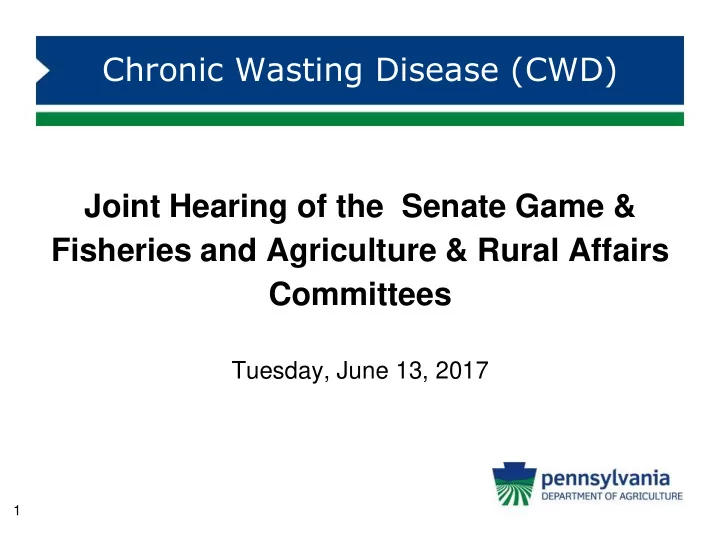

Chronic Wasting Disease (CWD) Joint Hearing of the Senate Game & Fisheries and Agriculture & Rural Affairs Committees Tuesday, June 13, 2017 1
CWD Facts • CWD belongs to a family of diseases known as transmissible spongiform encephalopathies (TSEs) • CWD susceptible species include: black-tailed deer; elk; moose; mule deer; red deer; sika deer; white-tailed deer; and hybrids of these species.(found in a reindeer but not yet on official list) • CWD is identified as a dangerous transmissible disease under the Pennsylvania Domestic Animal Law. 2
CWD Facts - continued There is no : • Treatment; • Vaccine; • Reliable live animal test; or • Practical means of testing soil for the presence of the prion. 3
4
Herd Certification Program (HCP) • The CWD HCP is a voluntary program approved by USDA APHIS. • The requirements are designed to determine the CWD status of domestic cervid herds. • 257 Pennsylvania herds have attained certified status for interstate movement. • 5 years of negative tests and program compliance • Emphasis: ID, records, annual inventory, testing, fencing, inspection, vet verified inventory 5
6
7
Herd Monitoring Program (HMP) • The Pennsylvania CWD HMP is the mandatory program for all captive cervid herds not enrolled in HCP. • 720 herds with HMP status are eligible for intrastate movement only. • Emphasis: ID only for movement and testing, annual inventory, fencing 8
9
10
Captive Cervids Tested 3,500 3,000 2,500 2,000 1,500 1,000 500 0 2002 2003 2004 2005 2006 2007 2008 2009 2010 2011 2012 2013 2014 2015 11
Captive Cervid CWD Positives • 6 CWD positive premises in Adams (1), Bedford (1), Franklin (1), Fulton (1) and Jefferson (2) counties o 3 premises depopulated and empty o 3 premises remain populated under strict QT • 13 CWD positive animals total • 21 CWD quarantined premises with exposed animals o 13 whole herds o 7 of the premises have no animals o 1 individual animal 12
As of March 17, 2017 13
14
CWD Management Plan • Together, we plan to review the 2011 response plan (2017 plan is in draft form) • The focus is on building a strategic plan to manage CWD in PA based on risk. • Key elements include: o Practical to implement o Uniform and consistent, whether inside or outside a fence o Addresses herd health o Public education 15
Cervid Herd Health In addition to CWD Programs: • Tuberculosis Accreditation Program o 222 cervid herds fully accredited • Brucellosis Certification Program o 222 cervid herds fully certified • Regular whole herd testing by accredited veterinarians with record keeping. 16
Questions? Contact Information Gregory E. Hostetter Deputy Secretary Pennsylvania Department of Agriculture 2301 N. Cameron Street Harrisburg, PA 17110 717-705-8895 www.agriculture.pa.gov 17
Why is Testing and Control such an Issue for Chronic Wasting Disease (CWD )? Joint Hearing of the Senate Game & Fisheries and Agriculture & Rural Affairs Committees Tuesday, June 13, 2017 18
The herd picture… The iceberg principle...
The iceberg principle… 1% Clinical + Age 4 heavy shedding Subclincal, Age 3 + shedding Subclincal, Age 2 no shedding Exposed Age 1
The iceberg principle… 0.1% Clinical + heavy Age 4 shedding + 9 normal Subclincal, + shedding Age 3 + 27 normal Subclincal, Age 2 no shedding + 81 normal Exposed + 486 normal Age 1
Statistics and Testing Prevalence 1% 1% 1% 5% 5% 5% Certainty 90% 95% 99% 90% 95% 99% N=10 10 10 10 10 10 10 20 20 20 20 19 20 20 30 30 30 30 24 26 29 40 40 40 40 28 31 36 50 50 50 50 30 35 42 60 59 60 60 32 38 47 70 68 70 70 34 40 51 80 76 79 80 35 42 54 100 91 96 100 37 45 59 150 118 130 143 39 49 68 250 151 175 210 42 53 76 1000 205 258 368 44 57 86
Reverse the Iceberg- Must change disease dynamics • Focus on bottom of iceberg not the top Environmental Survival Consequences • Minimize exposure of Infected Half life new animals host curve shedding Clinical level infection • Reduce shedding into Clinical disease threshold Number Subclinical the environment of Subclinical threshold infective disease • Strictly adhere to particles parts bans and movement restrictions Time 23
Questions? Contact Information David Wolfgang, VMD, MPH Director, Bureau of Animal Health and Diagnostic Services Pennsylvania Department of Agriculture 2301 N. Cameron Street Harrisburg, PA 17110 717-772-2852 www.agriculture.pa.gov 24
Recommend
More recommend